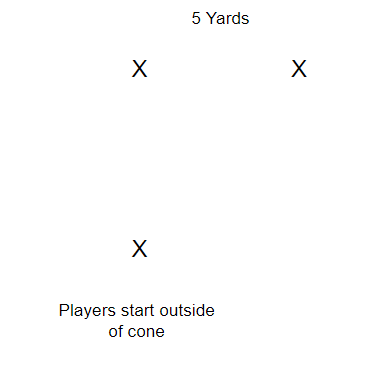Nfl Combine 3 Cone Drill Times
| rank | time (seconds) | year |
|---|---|---|
| 1 | 6.28 | 2018 |
| 2 | 6.42 | 2011 |
| 3 | 6.44 | 2011 |
| =4 | 6.45 | 2019 |
The 3 Cone Drill is easy to set up. Football players must grab 3 cones. Set the first cone down and walk in a straight line for 5 yards to set the second cone down. Now the football player must take a 90° turn to the right or left and place the third cone 5 yards from the 2nd cone. See all 2021 NFL Combine results by Position. 40 SPEED: 40-yard dash time. 3-CONE: 3-cone drill time. SHUTTLE: 20-yard shuttle time. The forty, weight, and 3 cone drill are the overall most important measurements, although there is variation across positions. The bench press is the least important. A decent improvement at the combine won’t take you from 3 rd string to super star, but it could take you from 2 nd string to starter, starter to pro bowl, etc.
Click to see full answer
Nfl Combine 3 Cone Drill Times
The 2015 NFL Combine gets under way this week and many in the fantasy football community are clamoring to see how their favorite players test. However, for as much hype as the NFL Combine drills re. The 3-cone drill bias also carries over to the team's current stable of running running backs. Brandon Bolden (6.96) and Tyler Gaffney (6.78) both posted solid times in the sub-6-second region.
Hereof, what does the 3 cone drill measure?
Three-cone drill. The three-cone drill, or 3-cone drill, is a test performed by American football athletes at the NFL combine. It is primarily run to evaluate the agility, quickness and fluidity of movement of players by scouts, particularly for the NFL draft but also for collegiate recruiting.

Also Know, how do you use a 3 cone drill? The 3 Cone Drill is easy to set up. Football players must grab 3 cones. Set the first cone down and walk in a straight line for 5 yards to set the second cone down. Now the football player must take a 90° turn to the right or left and place the third cone 5 yards from the 2nd cone.
Additionally, what is a good shuttle run time?
It's good for overall agility, speed and lateral quickness. A shuttle run time below four seconds is generally considered great, with the best players closer to the 3.8-second range. Kevin Kasper of Iowa set the shuttle run record at 3.73 seconds in 2001.
What is a good 5 10 5 shuttle time?
If you can run the 5-10-5 Shuttle in less than 4.5 seconds, you're doing pretty well. Any time under 4 seconds is downright blazing and would be a top-10 time at the 2015 NFL Combine. The ability to cover ground quickly defines speed.
40-yard dash
Why it matters: For wide receivers and running backs, breakaway speed can be the difference between a modest gain and a game-changing play (just check out Jerry Jeudy's film). A measurable combination that NFL evaluators pay close attention to for cornerbacks is length (height and arms) and 40 speed. Safety is another position to keep an eye on, particularly for players who will be asked to cover a lot of ground in the deep middle of the field. The chart below shows the most desirable times, the average combine times over the past five years and the times that should raise a red flag for evaluators.
Past standout: Seahawks WR DK Metcalf. At 6-foot-3, 228 pounds, we knew the Ole Miss stud was a physical freak. But then he broke the internet with a blazing 4.33 40 at last year's combine in one one of the most impressive performances I've seen. Seattle stole Metcalf at the end of Round 2, and he had a great rookie season, catching 58 passes for 900 yards and seven touchdowns.
Vertical jump
/cdn.vox-cdn.com/uploads/chorus_asset/file/19761826/usa_today_14110985.jpg)
Why it matters: The vertical can be an important indicator for wide receivers, tight ends and cornerbacks, but don't forget about running backs and defensive ends. This drill is a great judge of a player's lower-body explosiveness and ability to create power from the ground up.
Nfl Combine 3 Cone Drill Times Tables
Past standout: Giants RB Saquon Barkley. The No. 2 overall pick in the 2018 draft had an injury-plagued 2019 season, but you can't deny his lower-body power when healthy. Barkley posted a 41-inch vert two years ago, which was best among the running backs. And he did it at 233 pounds. Barkley wasn't that impressed, though. 'It wasn't my best,' he said afterward.
20-yard shuttle
Why it matters: It's not a coincidence that most of the positions listed below are on defense. Being an NFL defender is all about reaction: How quickly can you diagnose a play, come to a stop and explode toward the ball? And the 20-yard shuttle showcases a player's body control as he is changing directions.
Past standout: Panthers LB Luke Kuechly. The 4.11-second 20-yard shuttle Kuechly posted in 2012 is just outside the outstanding range above for inside linebackers (4.07 and below). That kind of short-area quickness, in combination with Kuechly's outstanding recognition skills, helped turn him into a five-time All Pro before he retired earlier this year. Next stop ... Hall of Fame?
Broad jump

Why it matters: I like to see how offensive linemen and skill players perform in the broad jump. You need good lower-body explosiveness, power and flexibility to anchor in the trenches. It's also a good way to separate which offensive linemen have the athleticism to play tackle. The top four broad jumpers of the past five years among O-linemen were drafted to play tackle.
Past standout: Eagles OT Lane Johnson. Remember when Johnson blew up at the 2013 combine? His broad jump was 118 inches. That's comparable to an above-average mark from a running back -- and he did it while weighing 303 pounds. Johnson's performance proved to scouts that he had the lower-body power to develop into a good left tackle.
Three-cone
Why it matters: This drill is all about assessing a player's ability to change directions quickly, bend and accelerate. Defensive backs and pass-rushers are good players to keep an eye on. Of course, a lot goes into being an elite edge rusher, but most of the NFL's best register outstanding times in the three-cone.
Past standout: Broncos OLB Von Miller. The Super Bowl 50 MVP completed the three-cone in 6.70 seconds in 2011, tied for the third-best mark among linebackers over the past six years. And that confirmed what teams saw on tape: a freak athlete who wreaked havoc off the edge.
Bench press

Why it's important: The bench tests upper-body strength by seeing how many times players can put up 225 pounds. Let's be honest: While it may be the most fun to watch, the bench press is the least important of all these non-football-related drills. But it does provide insight into the upper-body strength of an athlete, which tends to apply most to interior offensive and defensive linemen. There's also some small correlation for cornerbacks (for press-technique purposes).
Past standout: Rams DT Aaron Donald. The Pitt product showed off his raw strength at the 2014 combine, putting up 35 reps on the bench. That is tied for the second highest among all defensive linemen over the past three years. Donald, of course, has developed into one of the best defensive linemen in NFL history.
Related Stories
Nfl Combine 3 Cone Drill Times
Illustration by Todd Detwiler